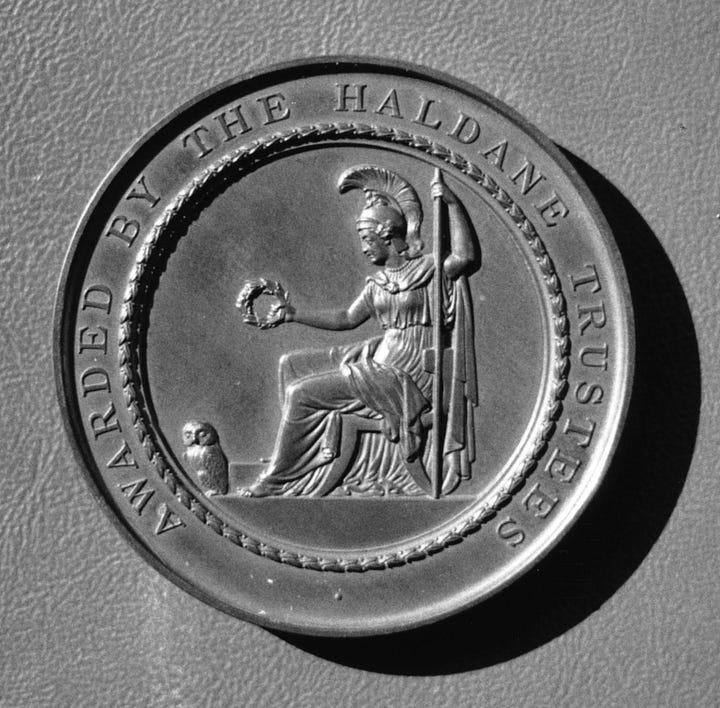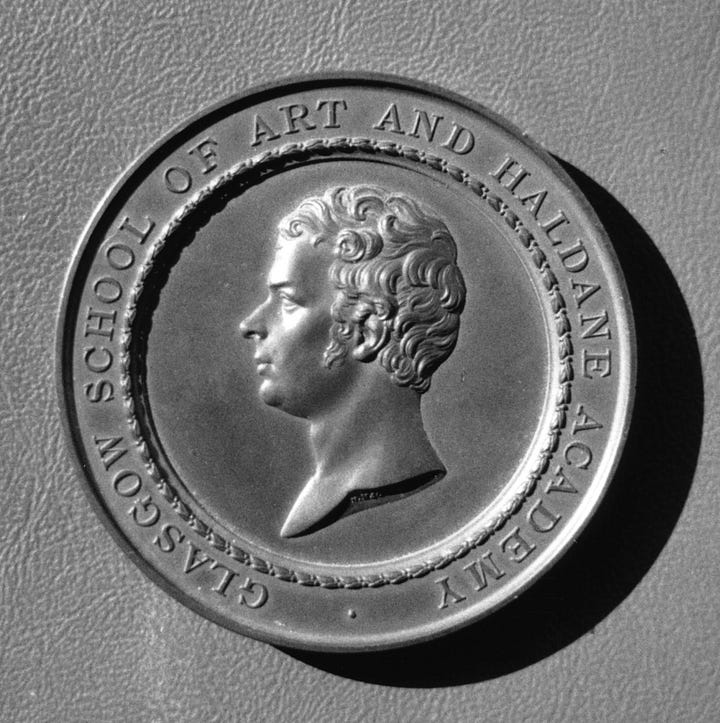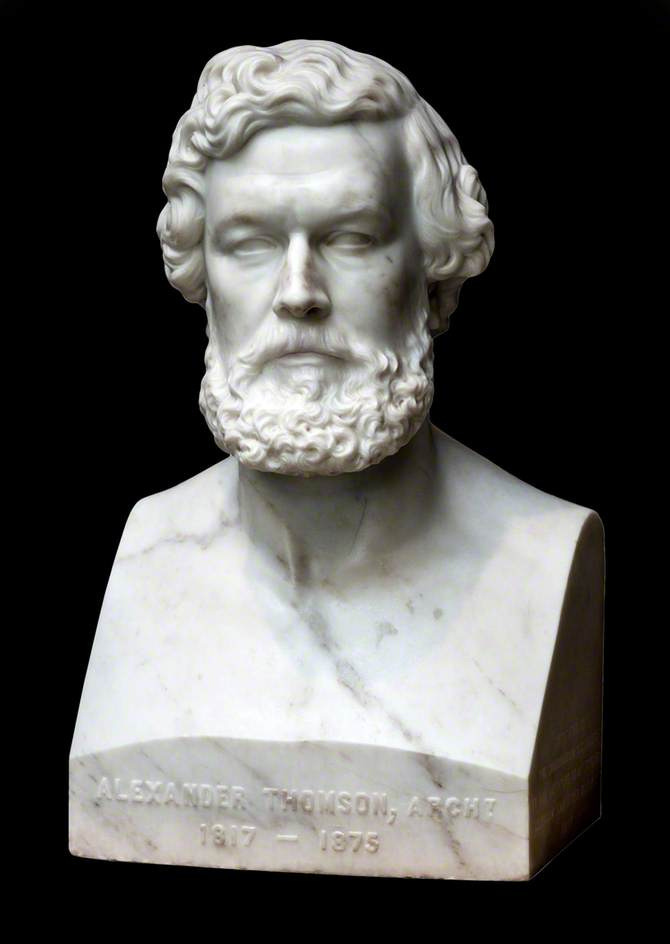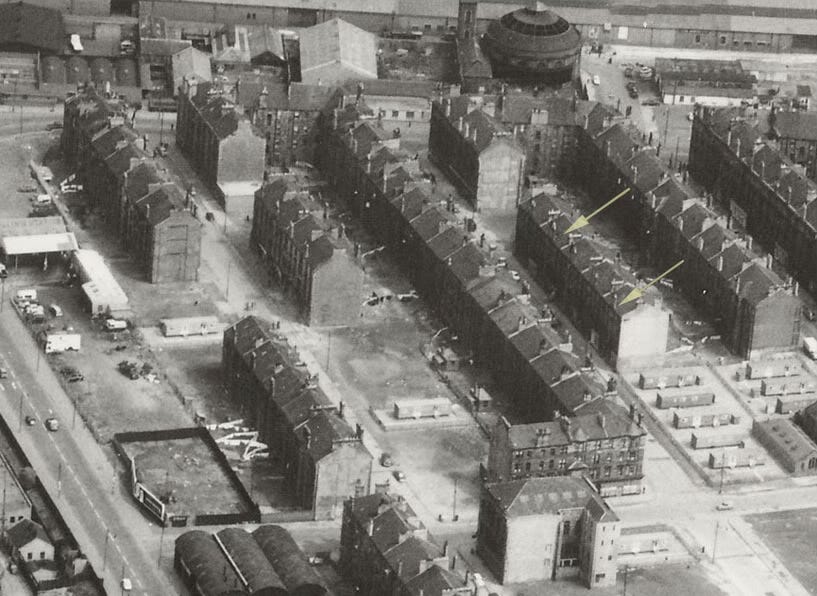The Memorial
Immediately after Mr. Thomson’s death, the Glasgow Institute of Architects initiated the movement for founding a memorial to him, and having invited the co-operation of Mr. Thomson’s non professional friends, the project was enthusiastically adopted, Subscriptions being received to the amount of £720.11.6, as detailed on the following pages, which, with £73.13.7 of interest accruing, was entrusted, by Registered Deed to the Council of the Glasgow Institute of Architects, with whom are associated, as Trustees for life, Robert Blackie, Publisher, John Mossman, Sculptor, John Shields, Measurer and Rev. John Stark, Duntocher.
The above sums having been devoted (1) to providing the marble bust of Mr. Thomson, executed by Mr. John Mossman (above), which is in the Corporation Galleries, Sauchiehall Street, and (2) to the purchasing of a feu duty yielding £26.13.1 per annum, payable from subjects in Blackburn Street, Plantation (arrowed, below), for the purpose of providing a travelling studentship for the furtherance of the study of ancient classic architecture, with special reference to the principles illustrated in Mr. Thomson’s works. This studentship is competed for every third year, and is open to Architectural Students between the ages of 18 and 25 years, residing in the United Kingdom, and qualified as described in the Deed of Trust1.
The £720 raised through contributions to the Alexander Thomson Memorial is equivalent in inflation terms to some £69,000 today. What do they tell us about the range of Thomson’s professional and personal connections?
For the purposes of brevity, biographies of the various architectural firms and their partners who subscribed are not given. Details of these can be found online here.
The Subscribers
The largest contribution, of £50, came from The Haldane Academy of Fine Art, established by engraver James Haldane, who had died some thirty years before2. Thomson designed the medal for the Haldane trustees, showing
Athena presenting a wreath to her attribute, an owl; on one side is a portrait of James Haldane and the inscription ‘Glasgow School of Art and Haldane Academy’ and, verso, ‘Awarded by the Haldane Trustees’3


Thomson’s series of lectures in 1874 were given under the auspices of The Haldane Trust.
£25 donors
The next largest donations, of £25, came from James Couper of Holmwood, Walter Macfarlane of the Saracen Foundry, and glazier Thomas Malloch.
James Couper, with his brother Robert, owned the Millholm paper mill in the valley of the White Cart. Around 1853, the brothers commissioned 74-76 Netherlee Road, designed in Thomson’s austere Gothic manner, and a similar pair of houses opposite Cove Pier (originally called Cove Cottage, now Ashlea and Ellerslie), around the same time. A couple of years later, Thomson designed Holmwood for James, while James Smith designed the nearby Sunnyside villa (now demolished) for Robert Couper. In 1870, Thomson designed a monument in Cathcart Old Parish Cemetery for James Couper’s first wife, Marion Harvey, who died in 1869. It was erected in 1870, altered in 1871, and again in 1877 after James Couper’s death.
Walter Macfarlane, ironmaster (1817-1885), 1850 took over a foundry in Saracen Lane, behind the Saracen Head Inn in the Gallowgate, and later relocated to Possilpark. The Saracen Foundry commissioned and produced many Thomson designs for ironwork, including railings, gate piers and lamp-posts.
Charles Malloch, glazier (1823-1877), chaired the Memorial Committee. The brothers Charles and John Murray Malloch established the firm of C & J Malloch after their father’s death (their father, Andrew (1790–1849), had opened a Glasgow ‘Crown Glass Warehouse’ by 1839). In 1873, the firm erected new premises at 28 Miller Street, which were destroyed by fire in 1891. The firm was selected to provide glazing for the new Glasgow University buildings, as well as cases for the Hunterian Museum’s display of stuffed mammals and birds. When Robert Baldie’s Bearsden United Presbyterian Church opened in 1874, the windows were gifted by Charles Malloch (The church was destroyed by a bomb in 1941 and later replaced).
£20 donors
Two £20 donors were John I Stevenson, IA, of London and George Thomson of Helensburgh.
John J Stevenson, IA (1831-1908) was a member of the Glasgow Architectural Society at the same time as Thomson. Stevenson’s ideas on ventilation in urban areas informed his speculative design of tenements for the City Improvement Trust.
George Thomson: Probably the first occupant of Baron's Point Village (now Baron Cliff) in Cove, where he was living by 1862, George Thomson (1803-1881) was probably the same person who occupied part of developer John McElroy's Ivy Cave Cottage (now Crag Owlet) at Cove ten years previously. He was a shawl and dress manufacturer in Glasgow who at one time employed 500 people. When the house was put up for sale in 1883 after his death, it was stated that ‘Mr Thomson having built the House, and laid out the grounds with great taste, for his own occupation…’4.
Two firms of architects, Clarke & Bell, and Douglas, Campbell & Sellars, gave ten guineas, as did writers Mitchells, Cowan & Johnston, and Dr William Cooper Thomson and his wife, of Partick.
Thomson’s influence on James Sellars's work can be seen in his Wesleyan Chapel in Claremont Street and Cowcaddens Free Church, St Andrew’s Halls, Kelvinside Academy, and his short-lived Employers Liability Assurance Corporation offices in St George’s Place.
Mitchells, Cowan & Johnston was a successor firm to Mitchell, Allardice & Mitchell, itself the successor to a law firm that was the second oldest in Glasgow (which eventually merged with the oldest and exists today as Mitchells Roberton). The two Mitchell brothers purchased the newly built Nos 1-7 Eton Terrace in 1862.
Dr and Mrs William Cooper Thomson: William Cooper Thomson was Alexander Thomson’s nephew by his older brother, also named William Cooper Thomson. He was a former missionary in Old Calabar who trained as a doctor and worked in Liverpool and Glasgow. Mrs Thomson was his third wife.
£10 donors
The Revd James Parlane of Burntisland gave ten pounds, as did three architectural firms: John Burnet, James Salmon & Son, and Robert Turnbull (the latter being Thomson’s last business partner).
Revd James Parlane, MA (1829-1906) was another nephew, the son of Alexander’s step-sister Helen. He was the United Presbyterian minister at Hawick before moving to Burntisland.
A similar sum came from clients: Alexander Adam of Langside Academy, publisher Robert Blackie, writers Murdoch & Rodger, and the Revd John Stark of Duntocher.
Alexander Adam, FEIS (1844-1919) taught Languages and Classics before becoming Headmaster at Langside Academy, which his widowed mother had commissioned from Baird & Thomson, together with the adjacent Edgehill Villa.
Robert Blackie, JP (1820-1896) of the Blackie publishing family, for whom Thomson decorated No. 7 Great Western Terrace (Thomson and Blackie were distantly related by marriage).
Murdoch & Rodger, solicitors, acted for Robert Blackie in relation to Great Western Terrace. James Murdoch was the first occupier of No. 3 Westbourne Terrace in 1871. The firm commissioned Thomson’s 1872 extension to their offices at 105-107 West Regent Street, which became A & G Thomson’s offices at 122 Wellington Street, and the 1874 conversion of the tenement at 126-132 Sauchiehall Street into the Washington Temperance Hotel. In the early 1870s, they also commissioned various properties in Lenzie, which may have involved Thomson’s office, although the evidence is weak.
Revd John Stark (1827-1889), Minister of the United Presbyterian Church in Duntocher, for whom Thomson designed a manse destroyed by bombing during the Second World War (see the article John Stark: The ‘autocrat of the manse’). There does not appear to be any evidence for the claim that he was a nephew of Alexander Thomson.
The largest group of contributors at this level came from individuals and companies who had worked with Thomson in a professional capacity. There were three firms of measurers - Henry Herbertson & Co., Shields & Duff, and T D Smellie - stonemasons Galbraith & Winton and sculptor John Mossman, George Smith of the Sun Foundry, Mr R T Middleton of West George Street, and painters C T Bowie & Co.
Henry Herbertson & Co. Henry Herbertson was the measurer who was caught up in the argument with John T Rochead over the cost of Rochead’s designs for the Unitarian Church in St Vincent Street, for which Baird & Thomson had been the original preferred architects. Herbertson himself died at home in Dowanhill Gardens in February 1876.
Shields & Duff: John Shields worked closely with Alexander Thomson and moved into 3 Moray Place when it was completed.
T D Smellie: in 1878, Thomas D. Smellie was a surveyor, valuator, and property
agent based at 209 St Vincent Street; house and living at No. 213.
Galbraith & Winton: William Galbraith was a monumental sculptor who originally worked in partnership with the builder William Neilson from 1837-59, before forming a partnership with David Winton. In 1862, Neilson built Eton Terrace. Both Galbraith and Winton died in the 1860s, but aside from any work the firm might have done for Thomson after that, Winton was a member of the Glasgow St John No. 3 bis masonic lodge, to which John Baird II and Alexander Thomson are both thought to have belonged.
John Mossman was Thomson’s friend and collaborator for many years. He created a bust of the 30 year-old Thomson in 1847 and commissioned from him a new studio and workshop at 83 North Frederick Street. He executed the sculpture for the Buck’s Head Building and the Wodrow and Isabella McCulloch monuments and modelled Thomson’s design for the GIA Seal. He created the Alexander Thomson Memorial Bust and the image of Alexander Thomson among one of the statuary groups for St Andrew’s Halls.
George Smith, Sun Foundry: Thomson is claimed to have provided designs for the Sun Foundry, but none seem to have been identified to date.
R T Middleton: probably Robert T. Middleton of Caldwell & Middleton, merchants and drysalters, whose offices at 179 West George Street had been remodelled by Alexander Thomson in the early 1860s (together with the neighbouring offices at No. 183, occupied by A & G Thomson until their move to 122 Wellington Street).
C T Bowie & Co: Campbell T Bowie & Co., painters and paper-hangers of 26 Bothwell Street. In 1858, the firm supervised the redecoration of the City Halls, much of it involving Greek decorative elements. In 1860, he gave a talk to the Glasgow Architectural Society on ‘House Painting; its means and results’, and was elected a member of the Society's Council of Management, of which Alexander Thomson was also a member.
From The ‘Alexander Thomson’ Memorial, courtesy of the Mitchell Library
See James Haldane, Engraver, in this series of articles
Gavin Stamp, ‘List of Works’, Alexander ‘Greek’ Thomson, London 1999
Glasgow Property Circular and West of Scotland Weekly Advertiser, 13 Mar 1883





